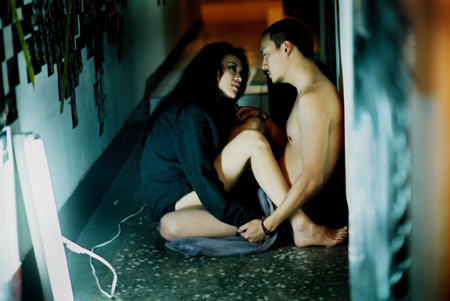|
Reviews of Recent Independent, Foreign, & Documentary Films in Theaters and DVD/Home Video
Directed by: Hou Hsiao-Hsien. Produced by: Hus-fu Chang, Wern-Ying Huang & Ching-Song Liao. Written by: Chu Tien-Wen. Director of Photography: Mark Lee Ping-Bin. Edited by: Liao Ching-Song. Released by: IFC. Language: Mandarin & Taiwanese with English subtitles. Country of Origin: Taiwan. 135 min. Not Rated. With: Shu Qi & Chang Chen.
As the title wistfully hints, the latest work by celebrated visual poet Hou Hsiao-Hsien constitutes three vignettes of a romantic couple, played each time by Shu Qi and Chang Chen, as they fall in love in 1966, 1911, and lastly, 2005. But instead of focusing on the exact unfolding of love, the film’s agenda is a near-perfect, sensual immersion.
Though clearly different in their time settings, all three share similar traits. The first, “A Time for Youth,” is filmed throughout as a long take facing the open door of a pool parlor, where sunlight continually floods in from the outside. The noise of colliding pool balls and the sounds of the Platter’s “Smoke Gets in Your Eyes,” a soundtrack chosen from Hou’s own youthful pool hall days, accompany Shu and Chang engaging in rounds, while their conversation is kept to a minimum. That is all that is needed for Hou to chronicle how the charged atmosphere surrounding the shy lovers begins to change, until the segment culminates in a shot of two, equally shy hands reaching out for one another.
The utterly breathtaking “A Time for Freedom” trumps the cinematic beauty of the first piece: restless courtesan Ah Mei is trapped within the confines of the ornate, wooden walls of a bordello. Beautifully adorned, every shot of Ah Mei is painstakingly composed, so much so that the director’s fascination with his leading lady at times borders on the indulgent. The romantic couples here engage in far more conversation than in “A Time for Youth,” but silently; the dialogue appears in intertitles – an effect which unexpectedly brings out the strength of Shu’s performance. It is with the slightest mist over her eyes or the flutter of her fingers that she communicates the proud Ah Mei’s debilitating heartbreak.
Definitely the bleakest among the three, Hou’s final short seems to be a tribute to lonesome lovers of the urban city, where connection becomes as depersonalized as a text message. Shu this times sheds the layers of elegance in place of mussed up, enticingly smoky make-up, as a singer whose aloofness captures the attention of a cameraman. Their hungry lovemaking and senseless betrayals are interspersed with the exuberant long take of them scurrying through Taipei on a motorcycle. Whereas the nostalgia embedded in the first two parts makes the lack of plot tolerable and the sole focus on ambience befitting, the idleness of “A Time for Youth” comes off as rather pretentious. But if Hou's portrayal of love lacks a profound or emotional connection with the viewer, it may be because Hou feels that love in the postmodern universe is too barren in nature to be salvaged.
Marie Iida
|

